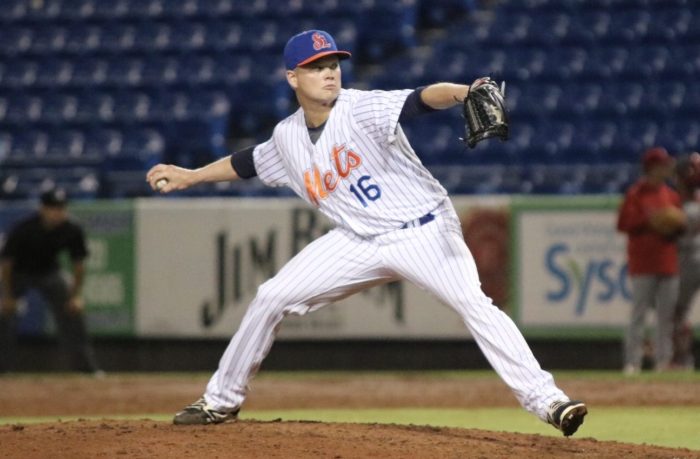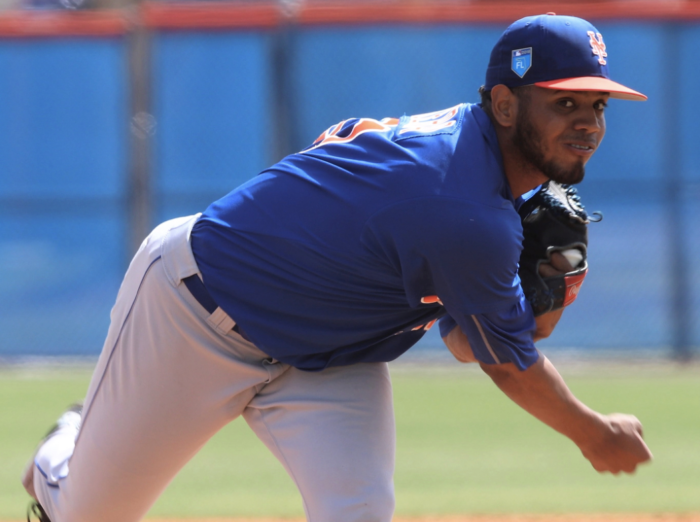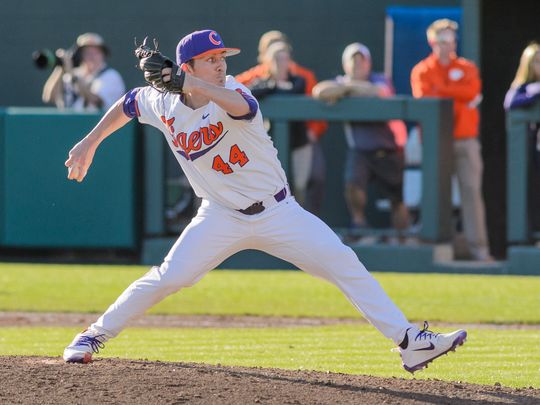
Ryder Ryan/Photo by Ed Delany, MMN
35. Ryder Ryan
Pos: RP B/T: R/R Age: 5/11/95 (23)
Acquired: Received from Cleveland Indians in exchange for OF Jay Bruce (8/9/17)
2018 Stats (St. Lucie/Binghamton): 3.23 ERA, 42 G, 53.0 IP, 59 K, 15 BB, 1.06 WHIP, 2.5 BB/9, 7.0 K/9
After coming over from the Indians in the Jay Bruce trade, Ryder Ryan saw some great success in 2018. Ryan started the season with 11.0 scoreless innings in a row and dominated A-Ball through the first half. In 2018, he was named to the Florida State League All-Star team and was subsequently promoted to Binghamton shortly thereafter. For the Rumble Ponies, Ryan struggled a bit. His transition to Double-A was not as smooth as he would have hoped, and there were obvious steps back in his performance.
Ryan, at only 23, still has a high ceiling for a reliever partially due to his ability to keep the ball on the ground. He also has a big arm with the ability to ramp up his fastball to 97 MPH. The biggest reason for belief in him going forward is his learning to better harness his pitches. With an obvious learning curve from someone who only began exclusively pitching when he was drafted, Ryan has seen his walk rate drop from 3.70 per nine with the Indians organization to 2.5 per nine last year.
He’s also held opponents to a .195 average in the Mets system, and part of that is due to a slider that has good bite. He also uses a simple delivery that has helped him transition quickly from a position player with success.
34. Patrick Mazeika
Pos: C B/T: L/R Age: 10/14/93 (25)
Acquired: 2015 Eighth Round Draft Pick from Stetson University
2018 Stats (Binghamton): 87 G, 295 AB, 32 R, 12 2B, 9 HR, 39 RBI, 35 SO, 39 BB .231/.328/.363
Mazeika struggled in 2018 due to issues ranging from uneven playing time and his BABIP cratering to .233. Aside from hoping for better luck in Mazeika, there is reason to see Mazeika perform better at the plate with his improving his walk and strikeout rates over what he had done in Double-A in 2017. Unfortunately for him, playing time may remain an issue with Tomas Nido likely starting the year in Syracuse, and the possibility of Ali Sanchez starting the year in Binghamton.
While he struggled at the plate, reports are he made strides defensively behind the plate, which is important because there have been questions about the 6’3″ Mazeika being able to stick at catcher. He has been a better receiver, and he continues to maintain a good caught stealing percentage (31.8 percent). With the injury issues of the two catchers at the Major League level, this is an important season for Mazeika because with a strong showing this season, he may very well find himself in position to earn playing time with the Mets. For that to happen, he’s going to have to hit like he did in previous seasons and continue progressing defensively.
Mazeika features a short line drive approach that has held down his strikeout totals in his career (10.3 K% in 2018 and 11.9 K% in career).
33. Matt Winaker
Pos: LF B/T: L/L Age: 11/29/95 (23)
Acquired: 2017 Seventh Round Draft Pick from Stanford University
2018 Stats (Columbia): 121 G, 425 AB, 65 R, 23 2B, 7 3B, 13 HR, 61 RBI, 88 SO, 62 BB .254/.370/.433
Winaker’s struggles from his 2017 debut season were a distant memory as he improved his SLG by 151 points. He would also go from hitting just one double with Brooklyn to accumulating 43 extra base hits with Columbia. Also promising is how he hit the ball much less frequently on the ground. Certainly, there is a correlation between hitting the ball in the air and seeing improved power hitting numbers.
The next step in his development is hitting for those power numbers while returning to the excellent walk rates which led to him being drafted. Ultimately, Winaker has an advanced knowledge of the strike zone, and he is learning not just how to drive the ball, but also which pitches he can drive.
Defensively however, the former first baseman has struggled in left field, where he primarily played in 2018. His lack of speed doesn’t help make up for a guy that doesn’t get good jumps.

Jaison Vilera (Ed Delany/Mets Minors)
32. Jaison Vilera
Pos: SP B/T: R/R Age: 6/19/97 (21)
Acquired: Signed as an International Free Agent from Venezuela on (11/10/15)
Previous Rank: 46
2018 Stats (Brooklyn): 1.83 ERA, 13 G, 73.2 IP, 78 K, 22 BB, 0.97 WHIP, 2.7 BB/9, 9.5 K/9
Entering his third professional season, Jaison Vilera was the ace of the Brooklyn Cyclones’ staff. In fact, he was the best pitcher in the league leading the league in ERA, WHIP, and strikeouts while being in the top 10 in most pitching categories. The reason for his success is Vilera has excellent control, and he combines his fastball, which tops out around 92 MPH, with a change-up, which keeps batters off balance.
With Vilera’s frame and age, it is reasonable to assume he is going to add an extra tick or two on his fastball. In addition to the previously mentioned change-up, he also has a developing and promising slider. The lack of a sure strikeout pitch is what is currently holding back his ceiling, and given his lack of top velocity, could ultimately force him to the bullpen.

Ryley Gilliam/David Grooms Independent Mail
31. Ryley Gilliam
Pos: RP B/T: R/R Age: 8/11/96 (22)
Acquired: 2018 Fifth Round Draft Pick from Clemson University
2018 Stats (Brooklyn): 2.08 ERA, 17 G, 17.1 IP, 31 K, 13 BB, 1.39 WHIP, 6.8 BB/9, 16.1 K/9
Gillam was thought of as one of the more polished relievers entering the 2018 MLB Draft, and he was tabbed by some as one of the draft picks who could be the first from this draft class to make it to the Major Leagues. That is what made his assignment to Brooklyn all the more puzzling. On the bright side, Gilliam did what was expected, and he dominated down in the New York Penn League.
The reason he dominated was because he was too advanced for the level. He paired a mid 90s fastball with a high spin curveball. That combination makes him very difficult to hit. At times, he can mix in an effective change. With his repertoire, he is going to strike out a lot of batters. The main issue going forward is his ability to limit his walks. The walks could be a function of his delivery where he whips the ball from a three-quarter arm slot and a rapid arm movement. The trick is harnessing that while not affecting the effectiveness of his pitches.
Gilliam is a guy that should start in St. Lucie for 2019 and get moved quickly up the ladder assuming he’s still striking guys out at a high clip and harnessing his control.
Editor’s Note: Jarred Kelenic, Justin Dunn, Luis Santana, Ross Adolph, Bobby Wahl, Adam Hill, Gerson Bautista and Felix Valerio were all in our original Top 50 before they were traded.
Previous Rankings:
50-46 Led by Michael Paez
45-41 Led by Ranfy Adon
40-36 Led by Anthony Dirocie

